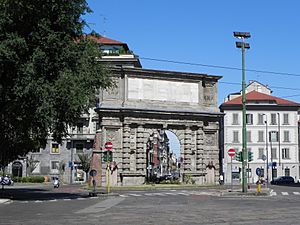Porta Romana (Milan) facts for kids
Quick facts for kids
Porta Romana
Imperial door
Imperial Gate of the City of Milan
|
|
|---|---|
|
Quartiere of Milan
|
|

Porta Romana
|
|
| Country | |
| Region | Lombardy |
| Province | Milan |
| Comune | Milan |
| Zone | 4 |
| Time zone | UTC+1 (CET) |
| • Summer (DST) | UTC+2 (CEST) |
Porta Romana means "Roman Gate" in Italian. It is a very old city gate in Milan, Italy. Today, the gate we see was built in the 16th century. It was part of the Spanish walls that protected Milan back then.
This gate has a much older history, though. Its story goes back to the Roman Empire. The Romans had a "Roman Gate" in the exact same spot. Porta Romana was the first and most important entrance to Milan for emperors and important visitors. It was also the starting point of the main road that led all the way to Ancient Rome.
Contents
History of Porta Romana
From Roman Times to Today
Porta Romana has stood for centuries as a key entry point to Milan. The original gate was part of the ancient Roman city walls. These walls were built to protect the city from invaders. The gate was named "Roman Gate" because it faced the road to Rome.
Later, in the 16th century, new walls were built around Milan by the Spanish rulers. They decided to rebuild Porta Romana. This new gate was much grander and stronger. It was designed to show the power of the city.
Why Gates Were Important
City gates like Porta Romana were vital in the past. They controlled who could enter and leave the city. Guards would check people and goods passing through. This helped keep the city safe and collect taxes.
Gates were also important symbols. They showed the strength and importance of a city. Porta Romana was especially significant because it was the main road to Rome, the capital of the Roman Empire.
Porta Romana Today
Today, Porta Romana is no longer a working gate that opens and closes. Instead, it is a beautiful historical monument. It stands in a busy part of Milan. The area around it is also called Porta Romana.
This neighborhood is now a lively part of the city. It has shops, restaurants, and homes. People can visit the gate and imagine what Milan was like centuries ago. It reminds everyone of Milan's long and rich history.
Images for kids



